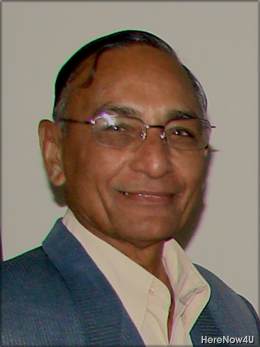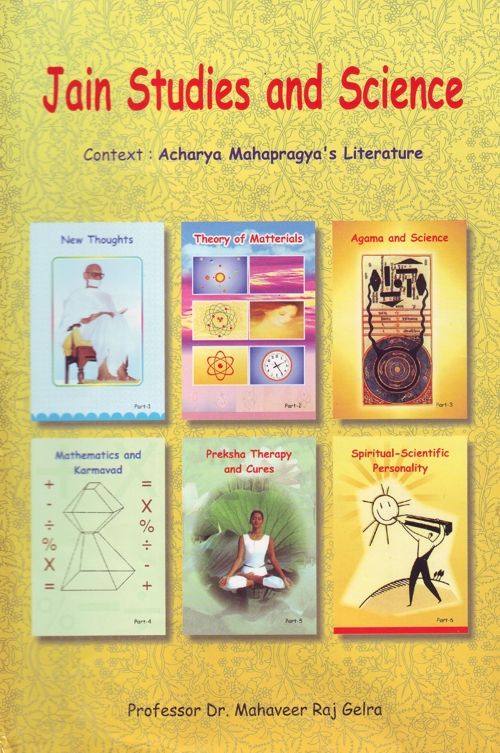Dwelling further into the descriptions of speed and motion available in Jain literature, Mahapragya has cited two very interesting mentions of fastest and slowest speeds of atomic motion -
- Matter or atom when travels at the slowest speed can move from one space co-ordinate to another adjacent to it in one 'time'. (Readers must recall that one 'time' is the smallest unit of time described in Jain literature).
- Contrarily, if it travels fastest, atom can travel from one end to another end of the universe in one 'time'. Two ends of the lok are 14 Rajju apart which is equivalent to infinite yojanas.
There are several instances in the Jain literature which can be explained only if the fastest speed possible is understood in further depth. According to the science, the fastest speed is that of a light ray which is finite and is equal to 3xl08m/sec. With this finite speed it is not possible to travel the entire universe in one 'time'. So, it is fascinating to explore what Jain thinkers wanted to propose by allowing near infinite speeds under peculiar circumstances? Mahapragya has dug deep into the ancient treatises and has explained it in a very logical manner. He states two kinds of possible motion -
- Sprashad Gati (Frictional Motion): Motion conducted by macro (sthul) particles. As the name suggests, particle under motion remains in physical touch with the surroundings. During the motion, it affects and gets affected by the environs. This is an ordinary motion relative to space and time. Here, the speed is ratio of distance travelled in the space and time consumed during the process. In this movement, the time is measured as samay, the smallest unit of time.
- Asprashad Gati (Non-frictional Motion): An extra-ordinary motion which is possible in micro matter (Sukshma) only. Travelling matter remains isolated from the surroundings such that it neither disturbs nor gets disturbed. This motion transcends space-time. Under this motion, the speed is assumed to be infinite which means that any distance can be covered in 'zero' time. In this movement, the time reduces to a moment.
Speed = Space (Distance)/Time, 0R, Time = Distance/ Speed, So if Speed = ∞, then, Time = 0
Such equations are not only mathematically true, but are said to follow under three exceptional circumstances -
1) Movement of soul during Re-birth (Re-incarnation): Soon after relinquishing the Sthul Sharira, that is, after death, the soul traverses to the destination of new birth place. Movement between the death and re-birth is called Antaral Gati or Period-motion. The description of this kind of motion is very interesting from science view point. It is said that the time elapsed during this motion is Ek Samay, i.e. moment-time in one direction irrespective of the distance travelled in that direction. Depending on the single or multiple directions covered during this event, Asprashad Gati could be of two types -
- Wrizu Gati (Motion in a straight line - unidirectional)
- Vakra Gati (Motion in a plane - bi or tri directional)
Soul undertakes Wrizu Gati when the place of re-birth is in the same direction that of the place of death, meaning thereby, the axis in the space remains the same. When the direction in space changes perpendicularly, it is referred to as Vakra Gati. In this motion up to a maximum of four units of time may elapse. This happens as a result of typical geometry of lok. The trusnadi is located vertically in the centre. In order to reach a place beyond it, the soul turns at right angle to exit this trusnadi. The geometry of entire universe is such that the soul can arrive at the destined re-birth place in a maximum of three mutually perpendicular turns.
Again, as mentioned earlier, the magnitude of distance covered is irrelevant. Since time elapsed is always one moment only, this motion, therefore, transcends the space-time frame.
(Author while translating this section, has struck a very interesting real-life practical application of this fact. If the modern cities are planned with only parallel and perpendicular roads, any person can reach anywhere with a maximum of three turns. This opens a possibility of an efficient public transportation system to be devised dispending with individual vehicles. The resultant comfort and safety of the citizens and the environmental benefits can be easily contemplated).
2) Movement of a Liberated Soul: When a soul (jiva) breaks free from the bondages of karma, it is said to be liberated from the cycles of births and re- births. At this moment, there are two possibilities, one is that of journey towards Shiddha-Shila and another is Kevali-Samudghath (a very special exception happening to those souls who goes on to become Tirthankara after Nirvana). In the former case, the liberated soul is said to find a permanent abode at Shiddha-Shila, situated at the top most boundary of lok.
This movement from Trusnadi to Shiddha-Shila is independent of distance and space. One samay or a moment-time is all that is required to cover this mammoth distance. This unique happening is the second case of singularity transcending the space-time barrier. The third example, described below, is actually a special case of movement of liberated soul.
3) Movement of soul during Ultimate Attainment (Kevali-Samudghath): Emancipation of soul is a unique phenomenon described in Jain literature in which the soul inflates (vyapta) to fill the entire lok-akash (universal space). During inflation, soul spreads in four time-moments to fully encompass the lok -
- First Time-moment: One dimension from bottom to top is linearly covered during this period. That is, the soul opens up downwards and upwards. The shape assumed by the soul resembles a stick.
- Second Time-moment: In this period, the soul spreads in left and right planes to form a shape resembling the two shutters of a door thus covering the second dimension.
- Third Time-moment: This period is for expansion in the third dimension. This is achieved by the spinning around the vertical axis. The shape is now almost like a cylinder standing upright.
- Fourth Time-moment: As we have studied elsewhere, the shape of lok is made up of pyramid type structures, there are several areas still left to be filled. All these left out pockets of space are filled in this last leg.
The description of movement of soul during the liberation is not space-time bound. The velocity attained is infinite to cover the entire dimension in one moment. German scholars have studied the Jain Agams very deeply and according to them the word Samay had been used in twofold manner. One describes the smallest 'unit of time' while the second stands for a unique 'moment of time'. In case of the soul attaining Nirvana, Ek Samay describes the exceptional moment. This concept of time is discussed in the chapter tilted 'Kaal'.
Scientific View
Modern physics has so far been able to demonstrate that only light has a motion which is beyond the laws of relativity. In the last chapter, we have stated that theoretically, only massless particles can achieve the speed of light. Physicists have conceptualised various such particles like gluon, graviton, photon etc. Devises like electronic microscopes, cathode-ray picture tubes have firmly established the presence of electrons. Similarly, nuclear reactors and study of stars have conclusively proved the presence of other atomic particles like neutrons and protons. However, mathematical derivation of massless particles has yet to become a physical and experimental reality. Though, in some sporadic experiments, scientists reported to have observed lasers moving faster than the light. A brief description of an interesting experiment is as follows -
Experiment: Physicists conducted an experiment in New Jersey, Princeton. In this, the laser beam was passed through the caesium vapour. They observed that the laser beams were emerging out even before entering the chamber. In common sense it means that the beams were travelling faster than the light. Though this experiment needs validation through the repetitive consistency, a hope exists in the scientific world to break the barrier of speed of light.
Conclusion
Motion in Sukshma and Sthula worlds are different. Soul or any micro entity travels at infinite speed thus rendering the time involved as a redundant entity. Time actually reduces to a 'moment'. In one moment of time, the micro entity can cover either a smallest distance from one space co-ordinate to the neighbouring one or can travel from one end to another end of the lok covering a distance of 14 rajju. Such examples are classified as exceptional and unique happenings which may be scientifically described as singularities. Asprashad Gati, as described in Jain Agams, if studied scientifically, can open up valuable lead to the scientists. Quark and other sub-atomic particles behave in a manner which is close to the characteristics of Sukshma Dravya mentioned extensively in the Jain literature. Science, hopefully, will unravel these secrets of Sukshma Dravya in the near future.
 Dr. Mahavir Raj Gelra
Dr. Mahavir Raj Gelra

